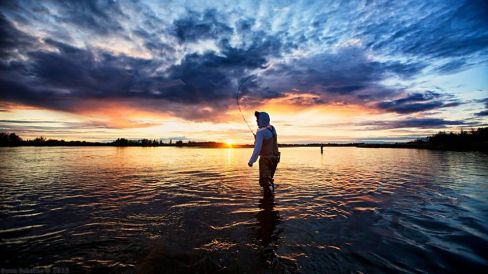End of SummerHatches
by Jim Misiura
Now that the days are getting shorter and the nights longer, the water temps will be falling. That’s good news for us fly fisherman. The colder water means more insects hatching. The hatch that I look forward to in September is the Blue Winged Olive. From now until the end of October, these mayflies provide one of the last chances to catch trout on dry flies. As the days cool off you will see the hatches coming off earlier and earlier in the day. By the time the hatch is over you will be fishing this hatch in the late morning. But for now the hatch will begin to start in the evening, around six or seven. If the day is particularly cloudy or cool the hatch will happen sooner. I prefer to use patterns in the size sixteen to eighteen range. I also like patterns that put more of the body of the fly in the surface film, patterns like the “Stuck in the Muck” or a Parachute BWO. Look for the BWO to hatch in riffles that are on the smooth side not too much white water. You will see the trout feeding on duns just below the riffle, as their wings take longer to dry with cooler air temperatures. On cloudy days the duns may float for one hundred yards or more before taking flight. This gives the trout plenty of time to decide if and when to take the dun. It also gives the angler plenty of chances to present their fly to rising trout.
Another hatch to watch for is caddis. Caddis hatch throughout the summer but when the water temperatures start to drop look for them in larger numbers. I like to use caddis patterns that are low in the water, imitating more of an emerging caddis rather than the adult. The caddis pupa struggles to break free of their shuck at the surface, making them easy meals. One very effective way to fish a caddis hatch is to use a two fly rig. Tie an elk hair as the indictor fly followed by a foot of dropper line with a pupa or GSS Emerger. A Griffith’s Gnat is also another great pattern to use as an indicator fly. Just as in the spring when a caddis hatch is coming off, rises to these flies can be very aggressive and exciting.
If you want to fish bigger flies terrestrials are a good option. Grasshoppers are plentiful, along with crickets. Don’t overlook days that are windy, very windy. In the late summer wind is our friend; many terrestrials get blown into the water becoming easy meals for hungry trout. If you’ve never fished a hopper pattern before you are in for a real treat. The trout, especially large trout, will take these flies with abandon, often making large splashy rises. If that doesn’t get your blood flowing then maybe you should be bowling.
Below are step by step instructions on the Blue Wing Olive and Elk Hair Caddis.
Blue Wing Olive: Size 14 – 20
Thread:Grey
Tail: Blue Dun Hackle
Body: Dark Olive Dubbing
Wing: Blue Dun Hackle Tips
Hackle: Blue Dun
Step 1 Lay down a base of thread ½ the hook shank and return ½ of that. This will be the placement of the wings.
Step 2 Tie in hackle tips facing forward, upright and divide.
Step 3 Tie in tail, length should equal to shank of hook.
Step 4 Wrap body using dark olive dubbing. Stop one wrap behind wing.
Step 5 Attach hackle between wings. If using two hackles wrap first one then the other. Stop hackle wraps one eye length behind eye. Tie off head, whip finish and apply cement head.
Elk Hair Caddis Size: 12 -20
Thread: Black
Rib: Grizzly Hackle
Body: Olive Dubbing
Wing: Elk Hair
Step 1 Lay down base of thread to bend of hook.
Step 2 Tie in grizzly hackle by tip.
Step 3 Dub body, wrap up to 1 ½ eye lengths behind eye of hook.
Step 4 Palmer hackle forward over body & tie off at wing position.
Step 5 Tie in elk hair for wing (even in hair stacker). Hold wing tightly so it doesn’t spin. Trim front leaving short clump of cut end. Whip finish and apply head cement.
Video tying instructions for these patterns along with the GSS Emerger, Griffith’s Gnat, Caddis Pupa, Grasshopper and many more can be found at WWW.TheFlyManJim.com.
Tight Lines, Jim Misiura



